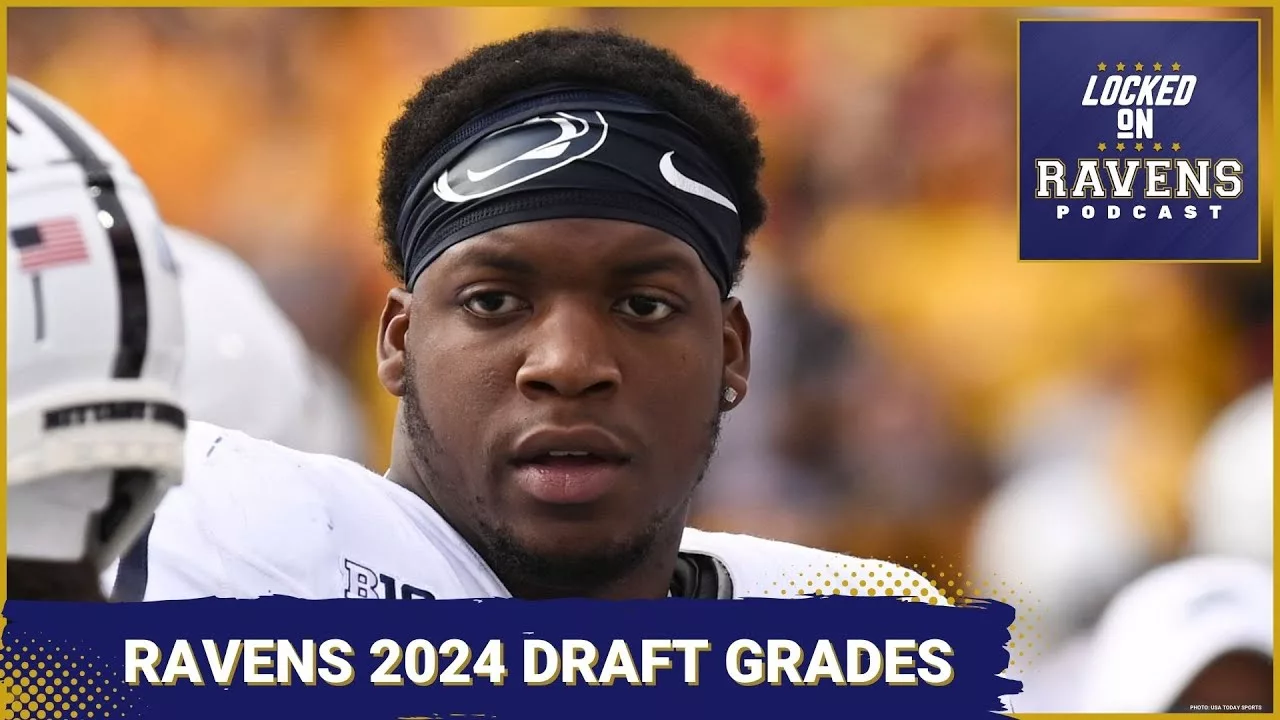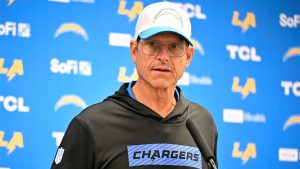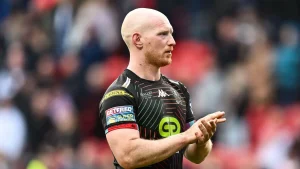
Early role projections for the Ravens 2024 rookie class as …
The Baltimore Ravens entered this year’s draft with nine draft picks at their disposal. They ultimately made no trades and stood pat in each spot, selecting nine players to fill out their 2024 rookie class.
The Ravens drafted four defensive players and five prospects on the offensive side of the ball. Three of their four draft picks on defense are defensive backs, and two of their prospects selected on offense are offensive lineman. While the dust has only just recently settled from the draft, we can make an early assumption as to what role each of these incoming rookies may play for the team in Year 1.
Let’s run through all nine of the Ravens’ draft picks and project what impact they could make in 2024.
Nate Wiggins, Cornerback
The Ravens’ first-round pick was one of the most athletic cornerback prospects in this year’s draft class. Wiggins has sub-4.3 speed and it’s apparent on tape. This elite trait allows him to stick with various types of wide receivers in coverage, close quickly and make plays on the ball.
Wiggins has some development and refinement to do still, which is not surprising given he’s just 20 years old. He particularly has room to grow physically to add more weight and muscle during his rookie season, which will help him acclimate to defending at the NFL level.
Fortunately, he’s entering a situation where the Ravens don’t need him to step in as an immediate full-time starter and handle matchups against opposing top wideouts. The Ravens already have a legitimate No. 1 cornerback in Marlon Humphrey and starter opposite him in Brandon Stephens, who is coming off a career-best season.
As such, Wiggins figures to play a No. 3 outside cornerback role behind these while playing consistent defensive snaps. The Ravens tend to move defenders around in the secondary often, which will afford Wiggins ample opportunities. His role will likely progress as the season goes along and starting action is certainly possible in the event of injuries.
Projected role: Rotational cornerback
Roger Rosengarten, Offensive tackle
The Ravens drafted their first and only offensive tackle in Round 2 with pick No. 62, landing Washington’s Rosengarten. This was viewed as a slight reach by some comparative to his ranking among all prospects, but the Ravens filled a need and landed a player they coveted highly.
Rosengarten started at right tackle for the Huskies in each of the past two seasons. He protected the blindside for one of the best quarterbacks in college, Michael Penix Jr., and played an integral role on a championship-caliber team.
Rosengarten is not a completely polished product but is capable of competing for a starting job right away. That’s what the Ravens envision for him and they have a vacant spot at right tackle after trading away veteran Morgan Moses. He possess high-level athleticism with good length and footwork, which are important foundational traits. His room for growth lies in timing, technique, and strength.
Rosengarten should jostle with rising third-year tackle Daniel Faalele this summer. Faalele also has room for development and has been inconsistent in limited opportunities through two seasons. Given his positional versatility, the Ravens could opt to deploy Rosengarten as a swing tackle early on before he could emerge as a starter late in the year.
However, the Ravens were high enough on him to select him in the second round ahead of some other viable tackles available. They clearly see a fit for him in the offense and will likely feel comfortable trotting him out as a starter right away. The onus is ultimately on Rosengarten to win the job and develop, but he’s talented enough to do so.
Projected role: Starting right tackle
Adisa Isaac, Outside linebacker
The Ravens landed another good value selection in the third round when they drafted Isaac, who started each of the past two seasons for the Nittany Lions and emerged as the team’s most disruptive pass rusher.
Isaac’s production increased from his junior to senior seasons and he recorded career-bests in total tackles (37), tackles for loss (16) and sacks (7.5) in 2023. The 6-foot-4 athletic edge rusher possesses untapped upside. He’s also strong against the run, where is edge-setting and pursuit to the ball stand out.
All of these skills should allow Isaac to make an immediate impact as a rookie. He does, however, have room to grow in areas like usage of hands, timing and fluidity. Isaac should benefit immensely from working with a pass-rushing guru like pass rush coach Chuck Smith.
Isaac is the only edge rusher the Ravens drafted this year. They re-signed veteran Kyle Van Noy in free agency and are returning three other young players in Odafe Oweh, David Ojabo and Tavius Robinson. Per usual, the Ravens will use a platoon of all players, which Isaac can slot into and carve out a rotational role. The potential is there for his role and snaps to increase as the year progresses.
Projected role: Rotational edge rusher
Devontez Walker
The Ravens’ first and only draft pick on a pass-catcher in this year’s class came in the fourth round, where they snagged Devontez Walker out of North Carolina. Walker is an explosive athlete with high-end speed and verticality. He has a good physical profile at 6-foot-2 and ran a 4.36 time in the 40-yard dash.
Walker’s skill set is a perfect match for the Ravens’ whose wide receiver core lacks a true vertical player who can win jump balls. Between Zay Flowers, Rashod Bateman, and Nelson Agholor, the Ravens have a good blend of speed and route-running but not a contested catch specialist. That’s where Walker thrives.
As such, while he’ll slot in as the No. 4 wide receiver on the depth chart behind these three players, he can have a role offensively early on given what he brings to the table. Walker’s shortcomings lie in his ability to consistently create separation and run precise routes, which is where he has the most room for growth.
However, the skill set he’s already adequate in should translate early on and make him a viable complimentary pass-catcher for Lamar Jackson in the passing game.
Projected Role: No. 4 wide receiver
T.J. Tampa, Cornerback
Despite using their first-round pick on a cornerback, the Ravens opted to double up at the position by selecting Tampa in the fourth round. Tampa was a quintessential “best player available” pick at the time. He was considered by many to be one of the 10 best cornerback prospects in this year’s draft and worthy of as early as a second round pick.
Instead, the Iowa State product slid into the middle rounds and the Ravens swooped in to take him off the board. Tampa is a long, athletic corner with a good physical profile and high-level coverage skills. His length and fluidity give him an advantage against many opposing wideouts and should translate at the pro level right away.
For the Ravens, like Wiggins but even lesser so, Tampa won’t need to step into a substantial role on defense from the get-go. He projects as the No. 4 outside cornerback on the depth chart behind Humphrey, Stephens, and Wiggins. However, with how much the Ravens tend to move and rotate players around in the secondary, Tampa should see opportunities to produce early. He also should be a consistent contributor on special teams.
Projected role: Rotational cornerback
Rasheen Ali, Running back
It was a given the Ravens would select a running back at some point in this year’s draft. They finally did in the fifth round, taking Ali out of Marshall. Ali was a multiple-year starter at the collegiate level and produced two separate seasons of 1,100+ rushing yards, 15+ rushing touchdowns and over five yards per carry.
Ali is an explosive runner with high-end speed and he possesses receiving ability out of the backfield as well. The Ravens have traditionally liked to have multiple running backs on the roster with diverse skill sets and Ali projects as a good scheme fit behind Derrick Henry and Justice Hill.
Ali will presumably slot into the No. 3 spot in the backfield while Keaton Mitchell pushes for a return from his torn ACL injury. Mitchell is likely to miss some portion of the regular season, which will afford Ali more opportunities for snaps. He also figures to be a special teams contributor and could see time as a kick or punt returner.
Projected role: No. 3-4 running back
Devin Leary, Quarterback
Arguably the most surprising draft pick the Ravens made was quarterback Devin Leary, who they selected in the sixth round out of Kentucky. Leary played five seasons in college and enters the league on the older side of many quarterback prospects at 24 years old.
He’s not an on-paper scheme fit for the Ravens as he lacks mobility and rushing prowess at the position. However, the Ravens evidently saw enough in him to exhaust a late-round pick to acquire him. Head Coach John Harbaugh indicated Leary would likely assume the No. 3 quarterback spot behind Josh Johnson, who will be Jackson’s primary backup.
In drafting Leary, the Ravens are showing uncertainty in Malik Cunningham, who is also in the mix as a potential third option. At a minimum, Leary will take important reps throughout the summer and adds some diversity of skill set and style into the Ravens’ quarterback room.
Projected role: No. 3 quarterback
Nick Samac, Center
With their first of two seventh-round picks, the Ravens drafted their only interior offensive lineman of the class with Michigan State’s Samac.
Samac started a lot of games in college over the past few seasons and is a pretty traditional middle-of-the-road center prospect you’d find towards the end of the draft.
He possesses good technique, footwork and hand placement. He’s at his best when run blocking, where his agility in space becomes valuable. Samac, though, has a lot of room for improvement in pass protection before he can become a viable contender for offensive snaps.
Fortunately, the Ravens are set at the position with Tyler Linderbaum. However, after losing Sam Mustipher, they don’t have a locked-in backup behind Linderbaum. Patrick Mekari could assume that role but the Ravens have favored using him as the primary backup at offensive tackle, where he’s performed well when needed.
As such, Samac has a clear path to emerging as the No. 2 center. He should begin to develop more throughout the summer and fine-tune some areas of weakness to become more of a viable roster spot-holder.
Projected role: Backup center
Sanoussi Kane, Safety
With their final pick of the draft in Round 7, the Ravens addressed their need for depth at the safety position by taking Kane.
Kane profiles as a prototypical box safety who plays physical near the line of scrimmage and is good in run support. This skillset can be valuable, especially as we’ve seen Kyle Hamilton do similar things very well over the past two seasons. Where Kane has room for improvement, though, is defending in coverage and playing deeper into the defensive backfield. That will limit what type of role he can play early on without quick development.
The last seventh-round safety prospect the Ravens picked, Geno Stone, turned out to be a undoubted success. Stone developed into a starting-caliber player and earned himself a larger contract and role elsewhere this offseason. Kane has a long way to go to replicate Stone’s story and the two are different players, so he’s not a seamless replacement.
The Ravens lack quality depth behind starters Hamilton and Marcus Williams at both safety spots. As such, Kane has a good path to making the roster and being a valuable special teams performer with the potential to see defensive snaps as well. It’s very possible though, if not likely, the Ravens may still add a veteran safety or two on the open market.
Projected role: Backup safety





